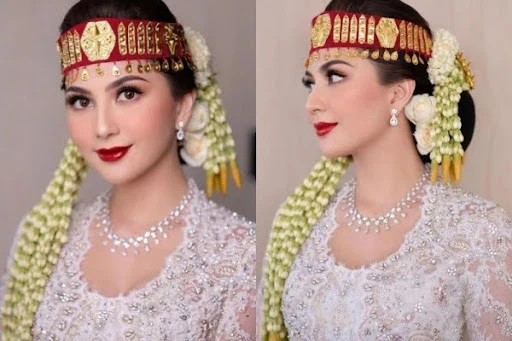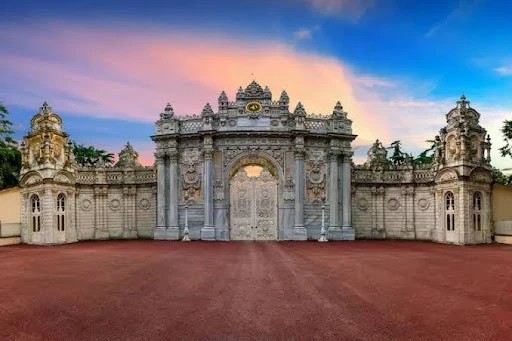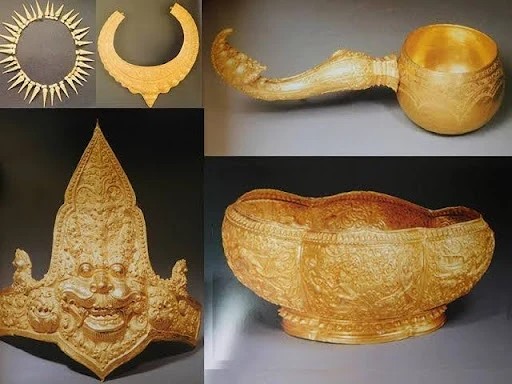Indonesia, blessed with abundant natural resources,
ranks among the world's top gold-producing nations. Gold serves multifaceted
roles, from investment and jewellery crafting to currency exchange. With their
perceived stability, precious metals like gold are often viewed as secure
investments, offering a hedge against inflationary risks and safeguarding
financial assets.
In this article, we will explore the rich history
of gold mining and production in Indonesia, uncover the cultural significance
of gold from the time of the kings (Rajas) to the present day, and
provide recommendations for the best places to purchase gold in Bali.
The History of Gold Mining
Gold
mining in Indonesia spans over a millennium, originating with the arrival of Chinese
immigrants. During Dutch colonial rule, the groundwork for Indonesia's gold
mining industry was laid. Extensive geological surveys in 1850 led to the
exploration of mineral resources, notably in Mimika, Papua.
The
captivating story of gold discovery in Indonesia owes much to the perseverance
of geologists. In the mid-20th century, Dutch geologist Jean Jacques Dozy was
intrigued by reports of Japanese plans to ascend Mount Carstensz in West Papua,
potentially encroaching on territorial interests. Determined to beat them to
the summit, Dozy and his team embarked on a challenging expedition. Upon
reaching the peak, Dozy identified promising geological formations indicative
of gold deposits.
News
of this discovery reached Forbes Wilson, a manager at Freeport Minerals
Company, who was inspired to launch an expedition for further investigation.
Negotiations followed, leading to the signing of a contract in 1967 for the
extraction of minerals in what became known as the Ertsberg mine. Eventually,
Freeport became the sole operator of the vast 10-square-kilometer site.
Gold
deposits were also discovered in the South Banten region, including the Cikotok
mine owned by PT Antam (Aneka Tambang). Additional mines, such as Lebong Tandai
in Bengkulu, were established between 1906 and 1910, followed by others like
Simau (1910), Mangani (1913), Salida (1914), Lebong Simpang (1921), and Tambang
Sawah (1923). However, most operations ceased during World War II, with only a
few mines reopening after the war.
Although
gold production remained relatively stagnant until the 1980s, with only about
2.6 tons recorded in 1985, there was a significant increase in production in
the following years. And of course, the Ertsberg gold and copper mine in Papua,
managed by PT Freeport Indonesia, played a crucial role in driving this growth.
Today,
the Ertsberg mine in Papua yields approximately 85 hundred ounces of gold daily,
contributing significantly to Indonesia's substantial gold reserves, estimated
at 1.76 million tons. Another noteworthy site is the Tujung Bukit mine in
Banyuwangi, East Java, managed by PT Bumi Suksesindo (BSI), which has been
operational since 2016 and boasts reserves of around 28 million ounces of gold.
For
those intrigued by the adventures of geologists and gold prospectors, the movie
"Gold" offers a captivating glimpse into the spirit of exploration
and discovery.

The Gold Refining Process: From Ore to Pure Gold
Converting
raw ore into pure gold entails a meticulous series of steps due to the presence
of impurities and minerals:
1.
Crushing: The initial step involves crushing the raw ore into smaller
pieces, facilitating subsequent extraction and processing.
2.
Separation: Once crushed, the ore is separated into different fractions
based on particle size and density. This segregation helps to concentrate the
gold-bearing material for further processing.
3.
Chemical Treatment: Chemical processes, such as leaching, are employed
to extract impurities and purify the gold from foreign substances. Leaching
involves dissolving impurities to separate them from the gold.
4.
Thermal Treatment: Thermal refinement further purifies the gold and
separates it from other components. This process involves heating the
gold-bearing material to high temperatures, allowing for the separation of
precious metals from other elements.
In
some cases, an alternative process called amalgamation is used to separate gold
from other components of the ore. However, this method involves the use of
mercury, posing significant health and environmental risks. Hence, safer
alternatives, like leaching, are increasingly favoured in refining practices.
While
modern refining processes often utilize heavy machinery and specialized
equipment, some traditional methods persist, albeit less commonly. For
instance, one traditional method involves mixing gold ore with sand in a
container to enable the gold to settle.
Documentary
videos detailing gold mining, including the refining process, are available on
platforms like YouTube, offering insights into the intricate procedures
involved. Examples include documentaries focusing on Freeport Indonesia and the
gold production process in regions like Papua.
Rose Gold
Rose
gold has gained popularity in Indonesia alongside traditional gold jewellery.
Its distinct reddish hue sets it apart from yellow gold, sparking curiosity
about its composition.

Rose
gold is created by blending pure gold with metals like silver, copper, nickel, bronze,
or zinc, enhancing both its colour and durability. Typically, it contains 75%
pure gold and 25% bronze, denoted as 18 karat (750 fineness), making it a
common choice for high-quality jewellery. Variants with a lower gold content,
like 14 karat (585 fineness), are also available, with a deeper reddish hue
depending on the copper or bronze ratio.
Interestingly,
rose gold, once popularized in Russia during the 1800s under the name
"Russian gold," saw a decline post-World War II. However, it has
resurfaced in Indonesia, and is now used in various accessories beyond jewellery,
including watches, bags, smartphone accessories, and clothing, thanks to its
affordability.
Despite
its popularity, rose gold may pose drawbacks such as allergic reactions due to
the copper content, making it unsuitable for those with sensitive skin.
Ultimately, whether choosing rose gold for its elegance or affordability,
understanding its composition and considering individual needs is paramount.
Gold in Indinesian Cultural Practices
In
Indonesia, gold jewellery holds profound cultural and social significance,
tracing back to ancient traditions upheld by communities such as the Badui of
Java and the Batak Karo of Sumatra. Beyond mere adornment, gold jewellery
symbolizes social status and economic prosperity.

Gold
plays a particularly important role during wedding celebrations, where it
becomes an integral part of attire, adorning the hair, necks, and hands of
locals. Through this display, community members aim to showcase their family's
affluence and prestige, and to emulate the opulent lifestyles of past kings,
known as Rajas in Indonesia.
This
raises an interesting question: Did gold truly exist during the era of kings,
as believed by the Batak Karo tribe? Are their cultural practices genuinely
inspired by the wealth and luxury of the Rajas of the Indonesian archipelago?
The Significance of Gold in the Time of the Kings
Since
the era of Hindu-Buddhist times, rulers and nobles of Java have held a deep
fascination with gold, often collecting it as a symbol of wealth and power.
Despite fluctuations in market prices, the value of gold remained consistently
high, reinforcing its enduring allure.
In
Central Java's village of Wonoboyo (Klaten Province), gold signified status and
authority among the ruling elite. Lavish
displays of wealth included opulent items such as tableware, royal chariots,
and palanquins, all adorned with precious stones.
Remarkably,
artifacts from this period,
including opulent tableware, rumoured to contain up to 50 kg of gold, attest to
the era's extravagance. Even domestic animals donned golden collars during
royal processions, highlighting the kingdom's opulence.
Archaeological evidence confirms
these treasures, dating back to the late 9th to mid-10th century, shedding
light on Java's rich history of gold craftsmanship.
Moreover, gold transcended mere
ornamentation; it adorned the Royal Palace of the Majapahit Kingdom (Istana Kerajaan Majapahit) with intricate carvings
and golden roofs. The palace, ruled by 13 monarchs from 1293 to 1527, stood as
a testament to Indonesia's royal splendour.

Golden Harvest
In the 1990s, fortune smiled upon six Indonesians
who unearthed a treasure trove in a rice field in Central Java containing gold
items and coins. This remarkable discovery, including approximately 7,000 gold
and silver coins, along with various ornaments and vessels, marked the largest
treasury of gold items in Indonesia.

Acknowledging their find, the government awarded a
prize of 500 million rupiahs which was split between the six individuals and
the landowner. This event sparked widespread fascination and led to the
creation of a documentary titled Misteri Harta Karun Emas dan Situs Wonoboyo Klaten, which
is available on YouTube.
Sale, Purchase, and Price of Gold in Indonesia
In
Indonesia, the pawnbroker Pegadaian plays a significant role in facilitating
gold transactions. It is a reliable state-owned enterprise for both buying and
selling gold. With branches evenly distributed across all regions of the
country, Pegadaian provides a convenient network for conducting gold
transactions.
Pegadaian
also has branches throughout Bali. For detailed information or inquiries, you
can reach them at +62361880498.

Another
prominent option for gold transactions is Antam. They offer gold bars and gold
coins for sale through their retail outlets and authorized distributors. To
manage the high demand at their branches, Antam has introduced a registration
system. Customers are required to register in advance and obtain a queue number
upon entering the branch, ensuring orderly transactions.
As
of December 20, 2023, the price of Antam gold was 625,000 IDR for 0.5 grams. In
contrast, 0.5 grams of 24-carat gold from Swiss UBS was priced at 596,000 IDR,
equivalent to approximately $38.
Besides
Pegadaian and Antam, numerous other shops across the country specialize in
selling gold and other precious items.
The
approximate prices for gold, inclusive of tax, are as follows:
- 0.5 grams - 614,000 IDR
- 1 gram - 1,128,000 IDR
- 3 grams - 3,268,000 IDR
- 10 grams - 10,771,863 IDR
Indonesia
exports gold to various countries, including Singapore, Switzerland, Hong Kong,
Australia, Thailand, South Korea, and China, as well as the USA, United Arab
Emirates, Japan, and Mexico.
Five Popular Gold Shops in Bali
Bali
offers multiple options for those looking to purchase exquisite jewellery.
Whether you're a local resident or a tourist visiting this enchanting island,
indulging in the beauty of precious metals is a common desire.
Here,
we offer recommendations for some of the reputable gold shops on the Island of
Gods:
1.
The Palace National Jeweler: Known for its welcoming ambiance and
knowledgeable staff, the Palace National Jeweler offers an extensive collection
of stunning jewellery pieces at affordable prices. Their website provides
comprehensive details and pricing for easy browsing.
Opening Hours: 10:00 AM – 10:00 PM
Official Website: Palace Jeweler
Phone: +6285351111188
2.
Melati Gold Shop: Renowned for its competitive pricing and
excellent customer service, Melati Gold Shop is a trusted destination for
buying and selling precious metals. Their commitment to fair pricing ensures
customer satisfaction.
Opening Hours: 10:00 AM – 9:00 PM
Phone: +623612096147
3. Gallery Kohinoor: Offering a diverse range of jewellery
designs, Gallery Kohinoor keeps its collection updated to cater to changing
trends. With an emphasis on customer satisfaction, they deliver exceptional
service and ensure a respectful shopping experience.
Opening Hours: 9:00 AM – 9:00 PM
Official Website: Gallery Kohinoor
Phone: +6287869999909
4.
Toko Perhiasan Emas Rosiana: Recognized for its quality craftsmanship
and adherence to international standards, Toko Perhiasan Emas Rosiana attracts
a steady stream of customers seeking top-notch jewellery pieces. Their
Instagram page showcases their stunning collection.
Opening Hours: 8:00 AM – 4:00 PM
Instagram: Toko Emas Rosiana
WhatsApp: +6281237877580
5.
Dewata Ayu: Ideal for budget-conscious shoppers
looking for elegant jewellery, Toko Emas Dewata Ayu offers a diverse selection
of gold pieces to suit every preference. Their Instagram page provides a
glimpse of their extensive collection.
Opening Hours: 7:30 AM – 7:30 PM
Instagram: Dewataayugoldshop
WhatsApp: +6281236808277, +6281237384984,
+6281337747737
Jewellery Shops in Denpasar
In
Denpasar, there's a bustling area lined with gold shops, offering a diverse
array of options for jewellery enthusiasts. Here's a glimpse of what you'll
find:

What
also sets this area apart is the presence of street gold traders right on the
sidewalk, displaying their wares in small glass cabinets. Here, you can engage
in negotiations until you strike a deal that suits both parties. Sometimes, the
prices offered here can even beat those found in the market.
The Natural Resources of Indonesia
In
general, Indonesia remains a land of mysteries and is abundant in natural
resources. Apart from its gold reserves, the country boasts significant
deposits of various metals, minerals, and rocks. Its rich array of mining
products includes silver, diamonds, platinum, phosphate, coal, natural gas,
crude oil, copper, marble, aluminium and tin to name a few.
You can add one right now!